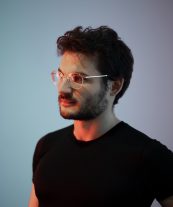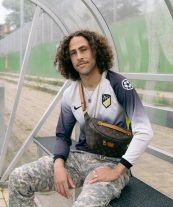COMMON GROUNDS: Marius Jopen x Diego Grandry
 1
1
 2
2
— ‘There is no distinction whether AI art is real or not’
Marius Jopen won the Dutch Design Award for Young Designer in 2016 with a very diverse body of work. He’s a visual artist, AI innovator, director, and lecturer, to name but a few of his many talents. He spotlights fellow visual artist Diego Grandry, likewise a multidisciplinary talent. Diego’s work explores how digital innovation can be used to create new visual languages for trailblazing stories.
Marius: “Diego’s work doesn’t take itself too seriously. I like the idea of exploring abstract worlds with humour – there’s an archeological weirdness in his imagery. To me, that’s truly wonderful.”
Diego: “To be honest, I didn’t think the humour in my projects was explicitly noticeable to viewers. I do try to infuse humour by introducing something that feels out of place, creating a weird friction that makes it stand out. So I’m happy this seems to resonate.’
Music
Diego: “I got my start in this field by designing an album cover, and eventually I became a V.J. (video jockey who creates a real time visual performance). As a visual artist working with moving images, it feels strange to imagine a video without sound. It’s like one of your senses is cut off.”
Marius: “I’ve always been drawn to visuals, and I also created beats, so I know how these tools work. It makes perfect sense to combine them, it’s a win-win. I’ve conducted numerous visual experiments, and they’d be quite boring without music. Like Diego, I V.J. as well and I find it beautiful when people can connect visually with music. A rave feels like a playground where these two worlds come together.”
AI
Marius: “AI is a tool that can generate worlds and compositions you can build upon. I still see my work as a craft. I constantly experiment with new digital tools and I enjoy merging different AI image models. I always tweak the outcome until I get the result I want. Recently I collaborated on a video we created with AI–it resembled hand-drawn crayon art. We then decided to trace a few of the digital frames by hand. While subtle, the enhancements improved the images enough for us to rework all the frames. We traced over a thousand frames by hand, to achieve that analog aesthetic. Diego, in the future how do you think we can recognize if art is real or made with AI?”
Diego: “I wouldn’t distinguish between AI art or ‘real’ art. Instead, I have a framework for evaluating the use of AI in projects. I question the ‘why’ and the ‘what for’: Is the reasoning sound? Was the intended goal reached? Does this work say something, and is that what you intended to say?”
Marius: “Sometimes I find AI art can feel trivial, when artists don’t document the process behind their AI generated imagery. Then it can seem like it’s just about picking a style and randomly applying it to a project, when it’s really about how style and context should work together.”
Diego: “I use AI in small drops. It’s never the finished product, it’s just one of the layers in my work. If I relied solely on a single prompt, the outcome would lack complexity. When the first prompt-to-image models emerged, they felt like an innovation with significant risks. Many feared they’d be out of a job within a few years. It made me wonder: am I just a prompt-machine now? Luckily a friend showed me how this ‘scary’ technology can genuinely benefit me. If you engage with it openly, you are not merely a passive maker, you have control.”
Teaching
Marius: “A few years ago, I ran a company that produced a science fiction feature film, where we had numerous interns. I genuinely enjoyed mentoring them and showing them the ropes. Currently, I’m teaching students at Hochschule Bielefeld to program their own AI. I love hearing their ideas and collaborating with them to improve their projects.”
Diego: “If I weren’t teaching, I’d really feel something was missing. I’m a big over-explainer, but really enjoy learning new stuff myself. My students constantly show me things that I had no idea existed, and that brings me immense joy.”
Practice
Diego: “I have this ideal of collaboration: where there’s a sense of equality between our contributions. I aspire to reach a point in my career where people want to work with me for my vision, not just the services I provide. It can be tough to monetize work that is so personal and infused with your own subjective thoughts. Marius, how do you balance your own projects with commissioned work?”
Marius: “I never wanted to be just a ‘graphic designer for hire’ exactly for the reason you set out, so I developed a secondary career. Fifteen years ago, I began building websites and now I have a web-design studio that provides me a degree of independence. I would like to develop my practice to a point where I can surround myself with other creative people: to collaborate on projects that I cannot tackle alone.”
Evelien Reich has served as chair of the Young Designer jury of Dutch Design Awards for the past three years. This year, she interviews the Young Designers that DDA has selected from the archives, as well as the emerging talents they choose to spotlight. All twenty Young Designers, both past and present, will showcase their work at the 2024 DDA exhibition during Dutch Design Week in Eindhoven, taking place 19 to 27 October.
Discover the work of Marius Jopen and Diego Grandy and all the other Young Designers of the Past & Present in the DDA24 exhibition at Microlab Hall on Strijp-S, during Dutch Design Week. From 19 to 27 October 2024 in Eindhoven.